Hindu Temple and Cultural Society of USA Inc.
Sri Venkateswara Temple (Balaji Mandir) and Community Center
780 Old Farm Road, Bridgewater, New Jersey 08807 (908)725-4477
http://www.venkateswara.org/
This article is a reproduction of articles found in the web site of Balaji Temple.
All rights apply to Balaji Temple.
Brahmotsavam:
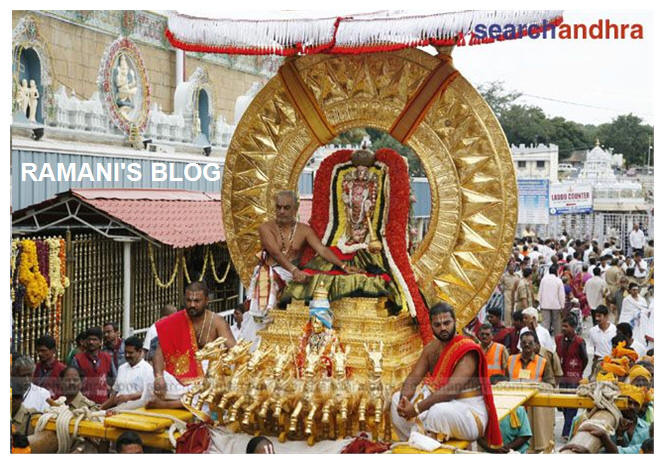
Utsavam means celebration/festival.
Brahmotsavam is a grand annual Temple celebration for nine days. This utsavam is conducted at different times in different Temples. There can also be more than one Brahmotsavam celebration during a year. In our Temple (Sri Venkateswara Temple in Bridgewater, New Jersey, USA), Brahmotsavam is celebrated during June/July beginning from Jyeshtha bahula truteeya (third day from fullmoon day in Jyeshtha masam). (It is important to note that most Hindu Temple celebrations vary every year in the English calendar date). Brahmotsavam is said to have been celebrated, for the first time, by Lord Brahma Himself; hence the name. Indra once killed a brahma rakshasa and thus had the burden of brahma hatya dosham. Lord Brahma wanted to relieve Indra of this burden/dosham. So, Brahma conducted a ceremony called Brahmotsavam. This festival starts with a flag hoisting in the Dwajasthamba, of the Temple, on the first day. This flag is also brought down on the last day of this festival. Homas and elaborate pujas are performed in the morning and evening during this nine day celebration. All the prayers are offered in front of the utsava moorthys. Deepotsavam with 1116 lamps and sahasra kalasa (1000) abhishekam to Lord Sri Venkateswara also form part of this nine day festival. A brahma sabha is also organized during this mega festival. This event is a very special program in which devotees exhibit their artistic talents (vocal music, instrumental music, and dance) in the main Temple area as an offering to Lord Sri Venkateswara. Sahasra Kalasa Abhishkam is part of Brahmotsavam festival. Water “mixed” with Special ingredients is poured in 1000 copper pots/kalasas. A coconut or orange is placed on top of these kalasas. These theertha kalasas are arranged, in a pattern prescribed by Religious Agamas, in an orderly way and devotees pass on all the kalasas, one by one, to the priests performing the abhishekam. May the Blessings of Lord Sri Venkateswara and Sri Mahalakshmi be with you and your family. HTCS
Deepavali
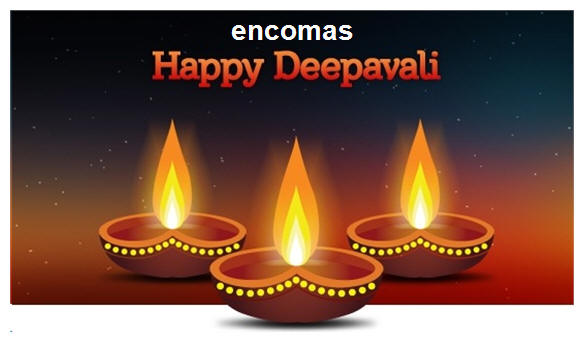
Deepavali is one of the most important Hindu festivals celebrated with a lot of social and religious significance. Deepavali is celebrated on the amavasya day of Aswayuja / Purattasi - Aippasi month (October / November). Hindus celebrate this function by wearing new clothes and feasting on special sweets. This festival is deeply enjoyed by all the Hindus and on this day, a super joy fills everyone’s heart. The significance of Deepavali cannot be explained in simple words. On this day, the festival of lights,devotees worship Sri Mahalakshmi, Goddess of wealth and prosperity. For some, this day also marks the beginning of a New Year. Legends relate this function to the defeat of Narakasura and Ravana, and to the story of Bali, a great Vishnu worshipper. In some parts of India, this festival is celebrated for five days, with each day being associated with a legendary story. In principle, this festival is for the triumph of good over evil. During Deepavali our Temple is open whole day. Morning pujas start with Sri Mahalakshmi homam and abhishekam, followed by a special sahasranama kumkumarchana in the evening. A graceful Dhanalakshmi alankaram adds to the Beauty of the Day. May the Blessings of Lord Sri Venkateswara and Sri Mahalakshmi be with you and your family. HTCS
Dhanurmasa Puja:
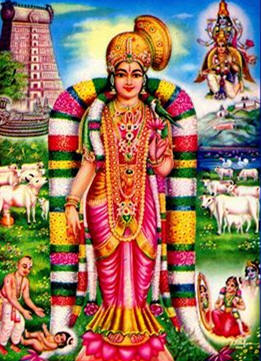
Pre-dawn worship has a special significance for Hindus. Early morning prayers are performed particularly during the Dhanurmasa (December middle to January middle) in most of the Hindu Temples. Dhanurmasa is also known as Marghazhi or Margasheersha. Lord Krishna in the Vibhooti Yoga of Bhagavad Gita says that among months He is Marghazhi. Such is the specialty of Dhanurmasa. Many Hindu saints advocated singing of the glory of The Lord, during the early morning hours when the mind is fresh, especially, during this month. Chanting of Thirupalliyezhuchi, Thiruppavai, and Thiruvempavai are part of Dhanurmasa pujas. A number of devotees look forward to participate in the month long early morning prayers. Thirupalliyezhuchi is a poem of 10 songs, in Tamil, rendered by Thondaradippodi Alwar (vaishanava saint). These songs bring out the glory of lord Vishnu in the Beauty of early morning hours. Thiruppavai is a poem of 30 songs, in Tamil, composed by Sri Andal, the only lady Alwar of the 12 Alwars (vaishnava saints) whose compositions of devotion and mystic experiences, put together is termed as Naalaayira Divya Prabhanda (4000 divine hymns). Sri Andal is considered as Sri Bhu Devi, the divine consort of lord Vishnu, who represents earth. Andal is also known as Sri Goda Devi. She was a great devotee of Lord Krishna and decided that she would wed none other than Lord Narayana. This innocent and pure devotee having a strong yearning for selfless service to the Lord, makes direct appeal to Him through her poems. Thiruppavai songs are in praise of the glories of Lord Krishna. Each one of the 30 songs of Thiruppavai are meant for each of the thirty days of the Marghazhi month. The composition of Thiruppavai is so lyrical, that it is set to classical ragas and sung by many leading musicians. The essential theme of Thiruppavai is to awaken and help devotees to make progress in the path with the goal of spiritual union with the Lord. Thiruvempavai is a set of poem of 20 songs (hymns), in Tamil, composed by saint Manikavachagar, one of the sixty-three saiva saints, known as Nayanmars. The theme of Thiruvempavai is about the spiritual awakening of the individual soul (jeevatman) to seek union with the paramatman (God) and is directed at Lord Siva as an intense prayer. Ten Tirupalliezhuchi songs written by saint Manikavachagar, as early morning prayers directed towards Lord Siva is also included in the Dhanurmasa Pujas. During Dhanurmasa our temple opens for Prayer at 5AM. Starting with Suprabhatam, devotees chant Thiruppalliyezhuchi, Thiruvempavai, Thiruppalliezhuchi, and Thiruppavai . Temple priests prepare special offerings to God and distribute the prasadams to the devotees after the early morning prayers. Goda Kalyanam is also celebrated during this month in our temple. May The Lord Sri Venkateswara of New Jersey Shower His Best on you and your family. HTCS
Ganesh Chaturthi:

Ganesh Chaturthi is one of the most popular of Hindu festivals. This falls on the fourth day after new moon (amavasya) on the Chaturthi day in the Sukla Paksha period of the month of Bhadrapada/Aavani (August/September). This function is celebrated over a span of nine days in our Temple. A special Abhishekam is performed every day to Lord Ganesha in the morning. This is followed by alankarams (decoration of the God) of different styles including vibhoothi, flowers, and sandal wood paste. We also perform Maha Ganapathy Sahasranama Puja (very special events in which the priests chant 1000 namas of Lord Ganesha) everyday in the evening. Lord Ganesha is the ‘remover of obstacles’, and hence he is worshipped before starting anything new. On Ganesh chaturthi day, devotees read a number of stories about Lord Ganesha. Two such stories are given below. Once Siva and Parvati had a special fruit and both the sons (Ganesha and Subrahmanya) wanted it. The parents then suggested that the one who circled the world three times and comes back first would get it as a prize. Subrahmanya got on the peacock, his vahana, and flew around the globe in high speed. Lord Ganesha, on the other hand is very slow on his vehicle, the mouse. However, he came up with a bright idea that led him to win the prize. He walked around his parents (Parvati and Parameswara) three times with great devotion. When his parents asked him why he was not circling the world like Subrahmanya, he answered that his parents are the whole world for him. He also said that he don’t have to go further to travel the whole world. Subrahmanya on returning back learned of this and accepted his defeat and bowed to his brother Lord Ganesha. Another story of Lord Ganesha is the one that leads the devotees to the story of Syamantaka Jewel, which is quoted in Srimad Bhagavatam (The story describing the life of Lord Krishna). Once in a moment of embarrassment, the moon in the sky had a laugh at Lord Ganesha and drew a curse from Him. When moon realized his mistake, Ganesha withdrew His curse. However, not completely. He made it known that seeing the moon on His birthday (fourth day after new moon) is inauspicious. The bad effect can, however, be nullified if one listens to the story of Syamantaka Jewel. Once Satrajit, a nobleman of Dwaraka, had a Jewel called Syamantaka, gifted to him by the sun God. This gem could produce eight measures of gold everyday to its owner. He gave this precious stone to his brother Prasena. The mysterious absence of Prasena made Satrajit suspect Lord Krishna to have played a foul play. Lord Krishna had not done anything wrong. So, Lord Krishna took all special efforts to trace the truth behind the missing Prasena. He found the corpse of Prasena. There were footprints of a lion nearby. Following these footprints, Lord Krishna entered the cave of Jambavanta. He fought with Jambavanta for 28 days. At last, Jambavanta understood that Sri Krishna was Sri Rama himself and handed over Syamantaka Jewel to Him. Lord Krishna gave the Gem to Satrajit and thus put an end to all the accusations against Him. Lord Krishna was surprised at all the things that had happened. He was told by The Great Sages, that the whole thing was because He saw the moon on the fourth day after new moon and Lord Ganesha’s curse on the moon. Lord Krishna then worshiped Lord Ganesha. The devotees believe that those who see the moon on this day will not suffer if they listen to the story of Syamantaka Jewel. May The Blessings of Lord Sri Venkateswara and Sri Mahalakshmi be with you and your family. HTCS
Janmashtami / Krishnashtami:
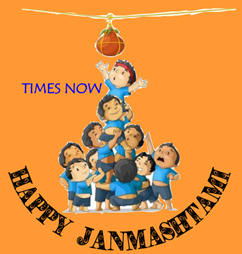
Janmashtami is the Birthday of Lord Krishna, the eighth avatar (incarnation) of Lord Vishnu. This festival is celebrated by all the Hindus, all over the world, as a great festive occasion. This special celebration is observed at home as well as the Temples. This occasion has a deep religious touch and is also filled with a lot of fun. Krishna, the Divine son of Devaki and Vasudeva was born on a stormy night in a prison as his parents were imprisoned by Kamsa, Devaki‟s brother and the ruler of Mathura. Kamsa had been killing all her children as he had been warned that her eighth child would be his nemesis. However, on this rainy night with the birth of Lord Krishna, the prison doors opened by themselves and helped Vasudeva to take the child across the river Yamuna. Due to heavy rains the river was flooded. But miracles happened one after the other. The rain stopped and the river parted making way for Vasudeva. He went to Gokul and placed the child near Yasoda, and took her newborn daughter and went back to Mathura. On hearing the news of the newborn, Kamsa came to the prison to kill this child. As Kamsa seized the legs of this child, it slipped away from Kamsa‟s hand and flew out into the sky. This child manifested as Durga, an incarnation of Goddess Parvati, and warned Kamsa that his destroyer is still alive and well, and disappeared. Lord Krishna was born on „Rohini‟ nakshatram (star) on Ashtami day. The actual celebration can be on two different days as the star „Rohini‟ and Ashtami may not be on the same day. This festival occurs on the eighth day (ashtami) of the dark half (Krishna paksha) of the month of Sravana/Aavani. This is celebrated over two days. The first day is Krishnashtami or Gokulashtami. The second day is Janmashtami. This festival is also called in different other names: “Krishna Jayanti”, “Sri Jayanti”. Main festivities of this event take place during the midnight (exact birth time of Lord Krishna). Devotees fast on this day and break their fast at midnight. They also spend the day immersed in Sri Krishna‟s glory by reading, reciting and singing his divine leelas (pastimes). Janmashtami celebrations in our Temple include the following: Sri Krishna Abhishekam; Fruit Alankaram; Sri Krishna Janana Ghatta Parayanam (Sri Krishna‟s Birth Story); Raj Bhog (nine varieties of Naivedyam); Bhagavadgeeta parayanam; Dolotsavam (Unjal / Cradle Seva); Butter pot breaking ceremony; and Rukmini kalyanam. (Bhagavadgeeta – containing the guiding principles of life was given by Lord Krishna to humanity). May the Blessings of Lord Sri Venkateswara and Sri Mahalakshmi be with you and your family. HTCS
Narasimha Avatar
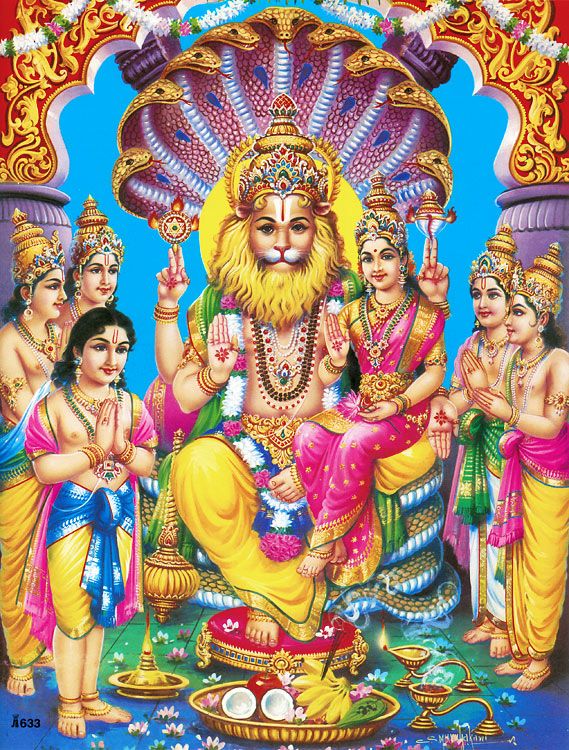
Narasimha, the fourth incarnation of Vishnu, is in the form of half-man (Nara) and half-lion (Simha), having four hands. Two hands carry a wheel and a conch-shell and two are in the boon giving and protection modes or tearing at the stomach of the demon-king, Hiranyakashpu. Vishnu assumed this form in order to overcome a demon king who could not be slain by a man or by a beast, either inside or outside a palace, by day or by night. Hiranyakashpu’s son Prahalad is a great devotee of Lord Vishnu. Prahalad was tortured by his father for his belief in God. One day during an argument, Hiranyakashpu challenged his son to prove the omnipresence of God. He asked, if he is in a near by pillar. Prahalad said yes and the demon-king kicked the pillar with his leg. Lord Vishnu sprang furiously out of the pillar and killed the demon-king, Hiranyakashpu, by sitting in the door step (neither inside nor outside), placing the demon-king on His lap and opened his chest with his fingers. As explained earlier, this is Narasimha Avatar. In this Avatar Lord not only kills the demonking, but also saves Prahalad (Hiranyakashpu’s son – a very pious young boy) and all His devotees who were tortured by the demon-king. May The Blessings of Lord Sri Venkateswara and Sri Mahalakshmi be with you and your family. HTCS
Devi Navaratri:
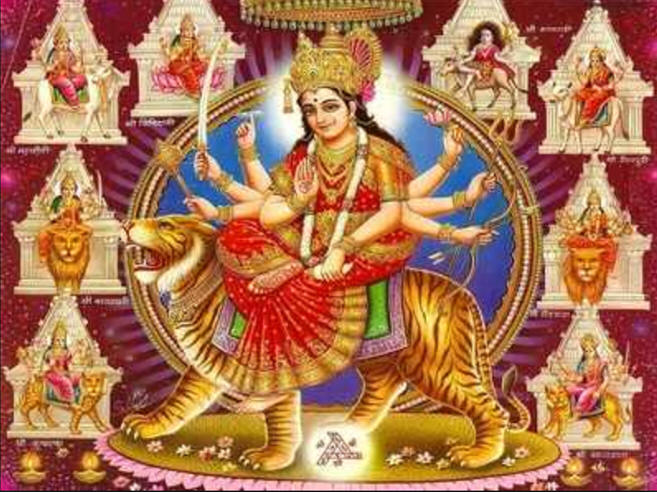
Navaratri literally means 'nine nights'. This nine day period (Prathama to Navami) of the first half of Aswayuja/Purattasi (Sep-Oct) month is considered a very important time of the Hindu calendar. During Navaratri, the three manifestations of the Goddess in the form of Lakshmi, Sarasvati, and Durga are worshiped for three days in sequence. All these three manifestations represent the three Cosmic aspects – namely, the sustenance, creation and dissolution. This festival is celebrated in various styles in different parts of India. In Bengal, this is referred to as Durga Puja. It is also known as Dassera in some parts of India. However, all of them worship Devi (Shakti) in different ways. The daily activities of this celebration range from a special group dance (garba) to golu (display of dolls) festival or processions of the Deity of Devi. This festival merges the cultural heritage with the religious worship. Nine different manifestations of Devi are worshipped during this festival. These are: Durga; Bhadrakali; Amba; Annapurna; Sarvamangala; Bhairavi; Chandi; Lalitha; and Bhavani. The tenth day is celebrated as Vijaya Dasami - victory day. Devi fought nine days to destroy evil elements from earth. The victory of Sri Rama over Ravana is also celebrated as “ Ram Leela” during this period. During the Navaratri period devotees observe special fasting and chant Devi stothrams every day. Friends make house visits to pray and enjoy different Golu displays. It is also a tradition to sing devotional songs in front of Golu. In our Temple, different alankarams (decoration of God/Goddess) are made for Shakti Devi during Navaratri celebrations. The alankarams include: Bala Tripurasundari; Kanaka Mahalakshmi; Parvati Sivapuja; Kasi Visalakshi; Maha Kali; Saraswati; Sri Kanaka Durga; Mahishasura Mardini; and Sri Raja Rajeswari. Daily prayers during this period include Lalita sahasranama (chanting of 1000 names of Devi) puja,Chandi (saptasati) parayanam, veda parayanam and Kalasa aradhana. A special Chandi Homam is also performed in our Temple as part of Navaratri celebrations. As shakti is associated with Devi, who is worshipped a lot during Navaratri, women participate more in these celebrations. During Navaratri, a Beautiful Golu is also on Display in our Temple. May The Blessings of Lord Sri Venkateswara and Sri Mahalakshmi be with you and your family. HTCS
Pavitrotsavam:
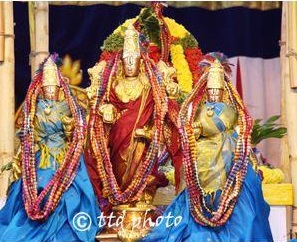
Pavitrotsavam is a special Temple festival. This function is celebrated annually during the Kartika month over a span of three days. The first day ceremony starts on the seventh day (saptami) after new moon day (during the sukla paksha period i.e. the days following New moon day). This celebration is called a sarvadhosa nivarana utsavam. This religious function removes all the blemishes that occurred in the Temple during the year, either knowingly or unknowingly. This festival purifies the religious sanctity of the Temple. The name Pavitrotsavam originates from the word Pavitram, which means suddham or auspiciousness. Pavitrotsavam is a purificatory ceremony of the Temple. A special yagnasala is made for this function. Temple idols are placed in the yagnasala or invoked in special kalasams. Homams and elaborate pujas are performed daily, during the Pavitrotsavam. Abhishekams to all the Moola Vigrahas are performed on the concluding day of this Temple festival. Colorful garlands are made for the Gods, using silk threads. Divine powers are invoked into these garlands and are offered to all the Gods. At the end of this festival these garlands are also distributed to devotees as prasadam. It is considered auspicious to keep these silk garlands at home for the sake of purity of the house. May the Blessings of Lord Sri Venkateswara and Sri Mahalakshmi, be with you and your family. HTCS
Pradosham:
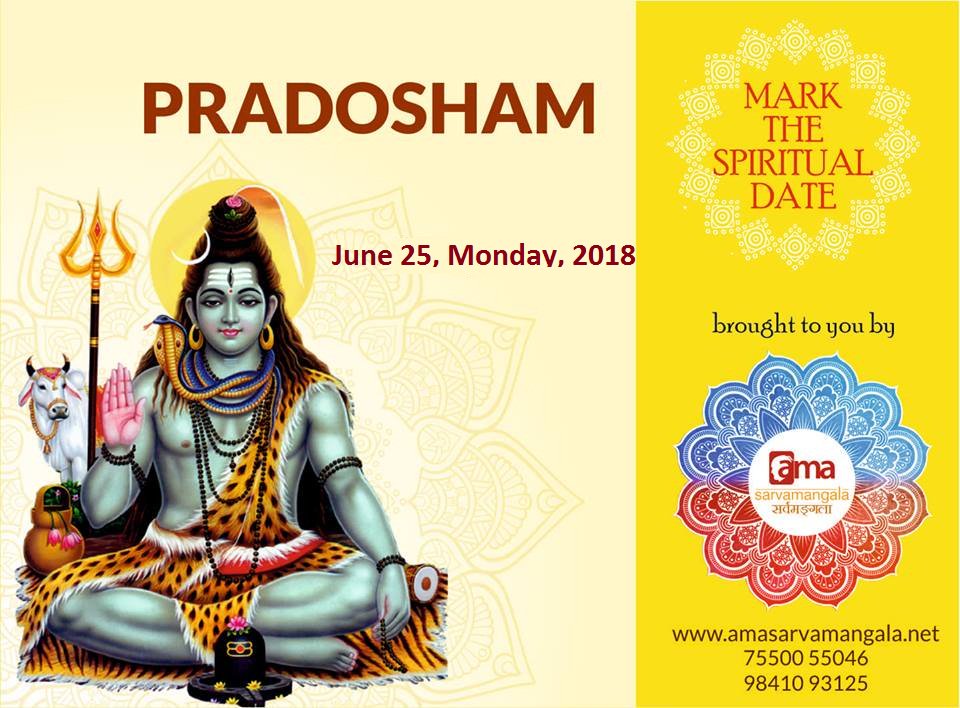
Pradosha Puja is very special to Lord Siva. The sunset time of Trayodasi (13th moon day) is called Pradosha. This Holy time comes once in Sukla Paksha (15 moon days from new moon to full moon) and again in Krishna Paksha (15 moon days from full moon to new moon). Worshiping Lord Siva during the Pradosha time is considered very auspicious. This prayer will free us from our sins and leads us to moksha. According to Puranas, Devas and Asuras used the hill Mandhara and the serpant Vasuki to churn the ocean of milk in quest for the Amrutham (Nector). To everyone’s surprise, the terrible poison came out first. This frightened all of them. However, Lord Siva came to the rescue and swallowed the entire poison. Following this, the churning process continued. Finally, on a Dwadasi day, Amrutham appeared. The story goes that the attention of the Asuras was diverted by Lord Sri Vishnu and the Devas got a chance to eat the Nector and celebrate. Only on the next day (Trayodasi), Devas realized that they didn’t thank and pray Lord Sri Siva. Lord Siva forgave them and performed a dance between the horns of The Divine Bull in The Pradosha time. Since then, devotees fast and pray Lord Siva, during the auspicious Pradosha time. In our Temple Siva Abhishekam is performed on Pradosham days and Vrushabha(Bull) vahana seva follows this. May the Blessings of Lord Sri Venkateswara and Sri Mahalakshmi be with you and your family. HTCS
Sani Trayodasi:
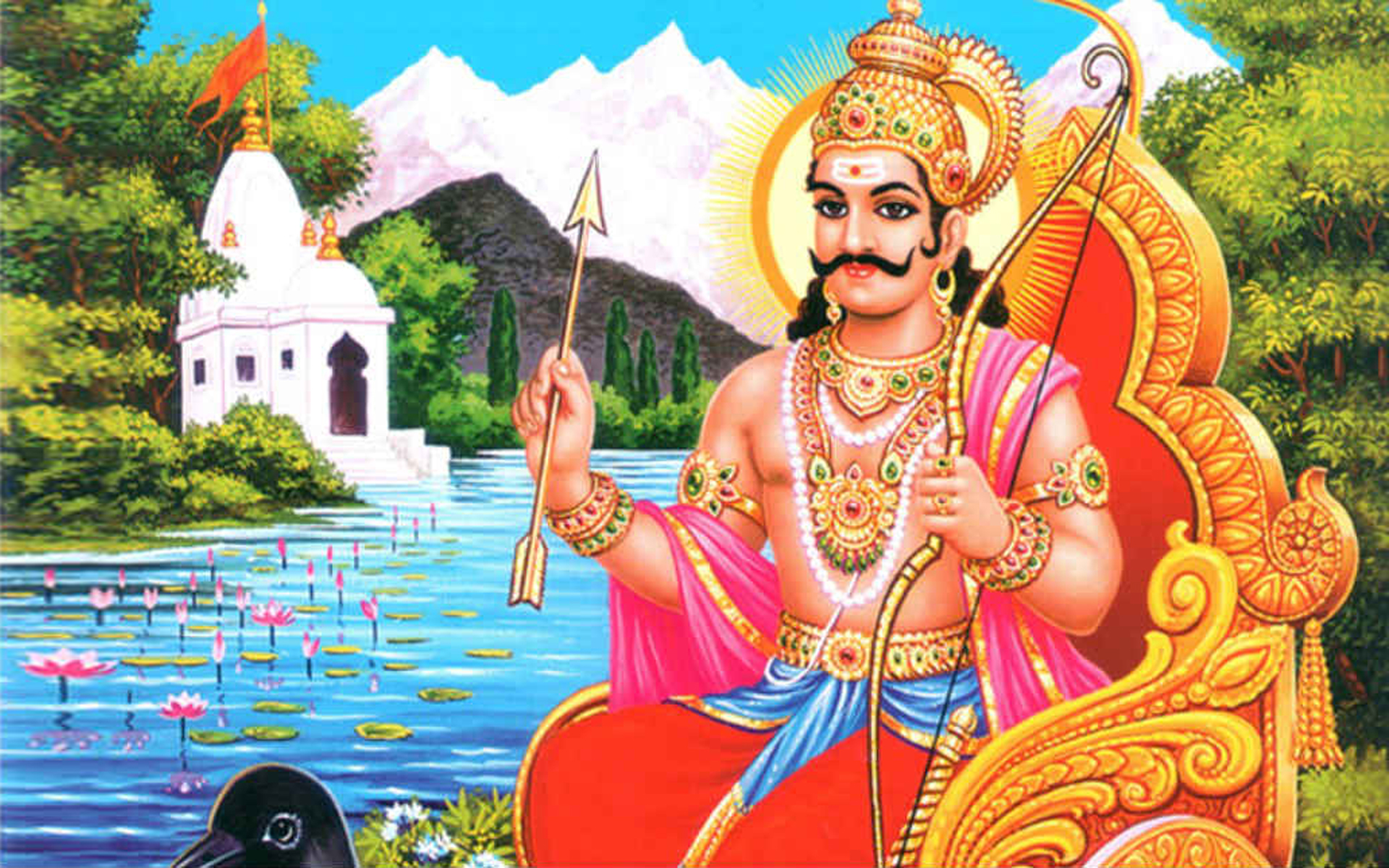
Sani (Saturn )is an important planet out of Navagrahas, the nine primary celestial beings in Hindu astrology. Sani is referred as the Lord of Saturday, the seventh day of a week. Sani is also known as Shani, Shani Bhagavan Shaneesvara, Shani Deva or Saneeshvaran. As per Puranas Sani is the son of Sun God, and is described as having a dark complexion with Beautiful face. According to Hindu astrology, the position of the Navagrahas has an impact on the life of each human being, specially Sani influence longevity, health, employment etc. Sani Trayodasi is celebrated on the day of Trayodasi when it falls on Saturday. Krishna Paksha Sani Trayodasi is considered even better to pray Sani Bhagavan (Krishna Paksha is the fifteen days following the full moon day, when the nights get darker and darker). On the Sani Trayodasi day, a large number of devotees come to the temple, to worship Lord Saneeswara and seek His Blessings. Special Navagraha abhishekam is performed with Oil ( Thailabhishekam ) on that day.. May The Blessings of Lord Sri Venkateswara and Sri Mahalakshmi be with you and your family. HTCS
Sankata Hara Chaturthi:
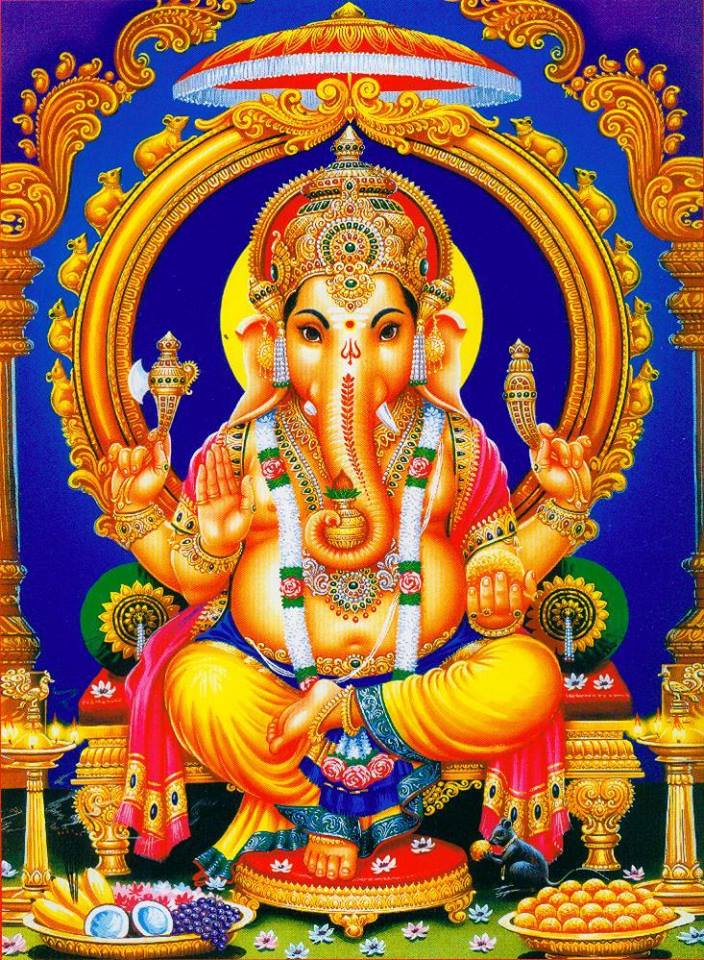
Sankata Hara Chaturthi Puja to Lord Sri Maha Ganapati is performed once a month on the fourth day (Chaturthi tithi) of Krishna Paksha(15 moon days from full moon to new moon) in the evening. According to Puranas, this puja was suggested by Lord Subrahmanya to sages to bring prosperity and happiness in life. Lord Ganesha Himself suggested this vratam to Sri Parvati, to receive the Grace and Darshan of Lord Siva. Lord Krishna advised the Pandavas to observe Sankata Hara Chaturthi vrata in order to win the war. Ancient literature also says that Lord Indra and emperor Harishchandra followed this vratam with various goals in mind. Devotees normally fast during this day and break their fast after performing Sri Ganesha puja and seeing the moon. Devotees also celebrate this vratam for one full year, once every month, and complete their Prayers at the end of the year by performing Ganapati Homam. In our Temple Maha Ganapati Abhishekam is performed on Sankata Hara Chaturthi days and Mooshika(mouse) vahana seva follows this. May the Blessings of Lord Sri Venkateswara and Sri Mahalakshmi be with you and your family. HTCS
Maha Sivaratri Maha Sivaratri is one of the most important Hindu festivals. Maha Sivaratri is celebrated on the fourteenth day of the dark fortnight (Krishna Paksha) of Magha month. (The religious events that take place for Lord Siva every month on this day is called Masa Sivaratri). As is evident from the name, this festival is celebrated to honor Lord Siva. One legend says that Lord Siva married Goddess Parvati on this auspicious day. It is also said that this is the night when Lord Siva performed the Tandava dance of primordial creation, preservation and dissolution. Maha Sivaratri being a moonless night, people worship the God who has the cresent moon as an adornment in his head, The Siva. Part of Maha Sivaratri celebrations include fasting and chanting bhajans in honor of Lord Siva. He who utters the names of Siva during Sivaratri with perfect devotion and concentration is freed from all sins. During Maha Sivaratri our Temple is open whole day and night. The day starts with Maha Ganapati Homam and Rudra Homam. Morning celebrations also include Sri Siva abhishekam and Parvati Abhishekam. Starting early in the evening abhishekams are performed to Lord Siva, The Siva Linga (an universal form of Lord Siva), in four phases at different time intervals. First abhishekam is performed following Mahanyasa Parayanam (Chanting to invoke Lord Siva in us). Rudra Trisati nama archana (300 names of Lord Siva which are extracted from Sri Rudram) is performed after the first Abhishekam. Bilva (bilva leaves) ashtottara satanama archana is performed after the second abhishekam. Phase three abhishekam covers Siva Sahasranama archana (1000 names of Lord Siva). Nandeeswara (Bull, the divine vehicle of Lord Siva) abhishekam, Siva Ashtottara Satanama Archana and Lalita Sahasranama archana form part of the fourth phase. Following each abhishekam, special alankarams are made for Lord Siva during which time devotees sing Bhajans in praise of Lord Siva. Harati, Mantrapushpam and Prasadam are offered at the conclusion of each abhishekam. May the Blessings of Lord Sri Venkateswara and Sri Mahalakshmi be with you and your family. HTCS
Maha Sivaratri
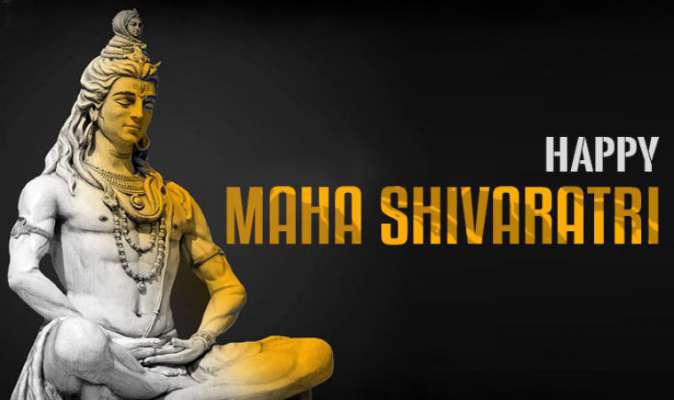
Maha Sivaratri is one of the most important Hindu festivals. Maha Sivaratri is celebrated on the fourteenth day of the dark fortnight (Krishna Paksha) of Magha month. (The religious events that take place for Lord Siva every month on this day is called Masa Sivaratri). As is evident from the name, this festival is celebrated to honor Lord Siva. One legend says that Lord Siva married Goddess Parvati on this auspicious day. It is also said that this is the night when Lord Siva performed the Tandava dance of primordial creation, preservation and dissolution. Maha Sivaratri being a moonless night, people worship the God who has the cresent moon as an adornment in his head, The Siva. Part of Maha Sivaratri celebrations include fasting and chanting bhajans in honor of Lord Siva. He who utters the names of Siva during Sivaratri with perfect devotion and concentration is freed from all sins. During Maha Sivaratri our Temple is open whole day and night. The day starts with Maha Ganapati Homam and Rudra Homam. Morning celebrations also include Sri Siva abhishekam and Parvati Abhishekam. Starting early in the evening abhishekams are performed to Lord Siva, The Siva Linga (an universal form of Lord Siva), in four phases at different time intervals. First abhishekam is performed following Mahanyasa Parayanam (Chanting to invoke Lord Siva in us). Rudra Trisati nama archana (300 names of Lord Siva which are extracted from Sri Rudram) is performed after the first Abhishekam. Bilva (bilva leaves) ashtottara satanama archana is performed after the second abhishekam. Phase three abhishekam covers Siva Sahasranama archana (1000 names of Lord Siva). Nandeeswara (Bull, the divine vehicle of Lord Siva) abhishekam, Siva Ashtottara Satanama Archana and Lalita Sahasranama archana form part of the fourth phase. Following each abhishekam, special alankarams are made for Lord Siva during which time devotees sing Bhajans in praise of Lord Siva. Harati, Mantrapushpam and Prasadam are offered at the conclusion of each abhishekam. May the Blessings of Lord Sri Venkateswara and Sri Mahalakshmi be with you and your family. HTCS
Sriramanavami
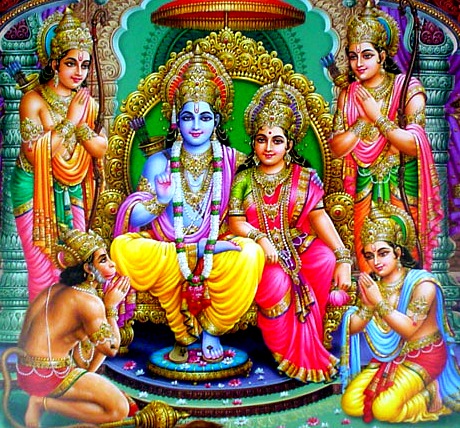
Sriramanavami is a well-known Hindu Holiday. Sriramanavami is celebrated on the ninth day of the Chaitra Sukla paksha (bright half of the lunar month Chaitra – March/April). This day also coincides with the star Punarvasu, the birth star of Sri Rama (The seventh incarnation of Lord Vishnu). Special festivities of this function include Sri Rama’s birth, Sita Rama Kalyanam, His victory over Ravana and His coronation ceremony. Vada pappu, Neer Mor (diluted buttermilk), Panagam (sweet herbal water) are few of the special prasadams significant of Sriramanavami. Sriramanavami celebration in our temple, a week long festivity, includes a number of religious activities. Daily Sundara Kanda parayana. (Sundara Kandam is that section of Valmiki Ramayanam, which deals with the heroic deeds of Hanuman/Anjaneya when he crossed over to Sri Lanka, discovered Sita, carried out a number of tasks and flew back to convey the news of Sita to Rama. Sundara Kanda parayana is believed to bring good news and hope) and Sri Rama Sahasranama Archana (chanting of 1000 names of Sri Rama) form special part of this event. On the Sriramanavami day, following the daily suprabhatam, Sundara Kanda parayanam and Sri Rama Janana Sarga (Sri Rama’s Birth story) Parayanas are performed. One of the Beautiful events that take place on this morning, after the parayanam, is The abishekam to Sri Rama Parivar (Sri Rama, Sri Sita, Sri Lakshmana and Sri Anjaneya) . Morning functions also include Sri Sitarama Kalyanam and Sri Rama Pattabhishekam. Annadhanam (distribution of free food - Prasadam) during Sriramanavami is a tradition in our Temple. Evening prayers include a Special Navaneetha Alankaram (decoration with butter) to Sri Anjaneya, an eternal devotee of Sri Rama. Hanuman Chalisa and Sri Anjaneya Sahasranama Puja (chanting of 1000 names of Sri Anjaneya) also form part of this religious service. May the Blessings of Lord Sri Venkateswara and Sri Mahalakshmi be with you and your family. HTCS
Ugadi:
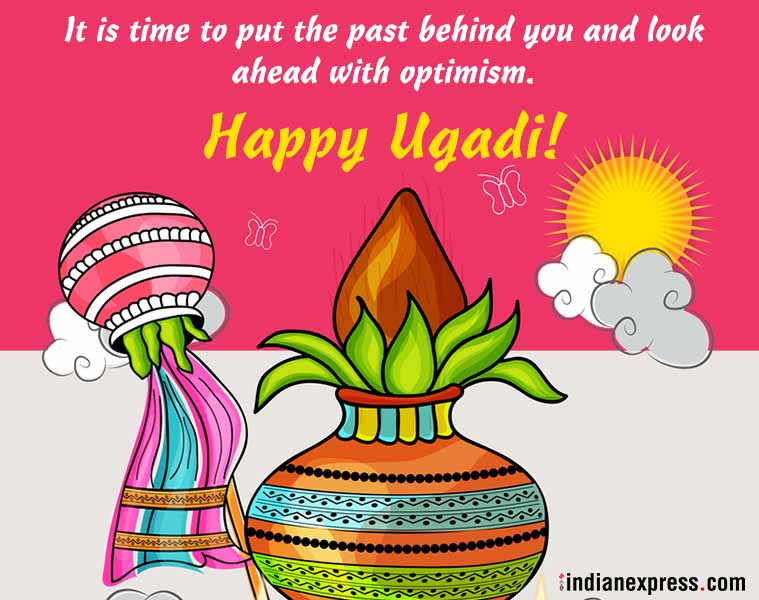
Ugadi (uga = year; adi = beginning) marks the beginning of a new Hindu lunar calendar with a change in the moon’s orbit. Ugadi heralds the beginning of a New Year, New month, and a New day. With the onset of the beautiful Spring season, Ugadi brings in lots of happiness. Ugadi falls on the first day of Chaitra masa during the bright fortnight (sukla paksha). Chaithra Masa (month) ends the shivering winter season and the beginning of new life, shoots and leaves. We find happiness booming everywhere. Naturally, it is the happiest day of the year. The dawn of Spring signifies growth, prosperity and well-being. While this is called ‘Ugadi’ in Andhra Pradesh and Karnataka, it is known as ‘Gudipadava’ in Maharashtra.Though Kannadigars, Konkanis, Kashmiris, Marathis, and Telugus in particular celebrate Ugadi, all the Hindus enjoy and participate in this celebration. People listen to Panchanga (Religious yearly almanac) on Ugadi. Experts will open the new Panchanga on the day and explain the forecast of rain, crop, storms, crop prices and other relevant things pertaining to our day today life of the New Year. This is called Panchanga Shravana. On this day, it is the practice to eat ‘Ugadi Pacchadi’ (Ugadi Chutney). This special preparation is made from neem flowers, honey, sugar, and a number of other ingredients with special tastes. This preparation signifies that life is a mixture of happiness and sorrow, and that we have to treat them alike. On the Ugadi day, we perform Abishekam to all the Deities in our Temple. This is followed by Panchanga Shravana in Telugu and Kannada. May the Blessings of Lord Sri Venkateswara and Sri Mahalakshmi be with you and your family HTCS
Vaikuntha Ekadasi:
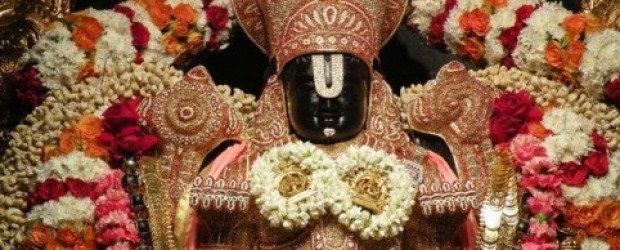
Ekadasi in Sanskrit means eleven. Ekadasi is the eleventh day of the fifteen-days of the bright half (Sukla Paksha) and is also the eleventh day of the dark half (Krishna Paksha) of the lunar month. In the Sukla Paksha the moon grows from new moon to full moon and in the following half it diminishes from full moon to new moon. Ekadasi day is auspicious to Lord Vishnu. The Ekadasi day that falls during the Sukla Paksha of Dhanurmasa/Margahi (December middle to January middle) is very special. On this day, it is believed, that the gates of Vaikuntha are ceremoniously open for devotees to enter. This day is celebrated as Vaikuntha (Abode of The Lord Sriman Narayana) Ekadasai in all the Vaishnava Temples. Stories from Puranas say that Lord Krishna discussed the special significance of Vaikuntha Ekadasi in one of His conversations with Yudhishthira. The Lord says that there is no better fasting day than the Ekadasai of the light fortnight of the Margazhi (Dhanurmasa) month. Who so ever is able to strictly observe this sacred Ekadasai, with worship, meditation, and fasting achieves complete liberation from the cycle of life and death. In some Vaishnava Temples, they have Vaikuntha Dwaram (special doors that are symbolic of the doors to Vaikuntha) and are kept open on Vaikuntha Ekadasai day. Pilgrims pass through this gate on this auspicious day. In our Temple in Bridgewater, a nicely decorated Vaikuntha Dwaram is made on this special day. Lord Sri Srinivasa with Sri Devi and Bhu Devi gives direct Blessings to the Devotees, as they walk through this Vaikuntha Dwaram . Also, on this day, devotees get a chance to worship Lord Sri Venkateswara in close quarters from The Mukhamandapam. Special prayers and Bhajans are also conducted on this holy day. May The Blessings of Lord Sri Venkateswara and Sri Mahalakshmi be with you and your family. HTCS
Varalakshmi Vratam:
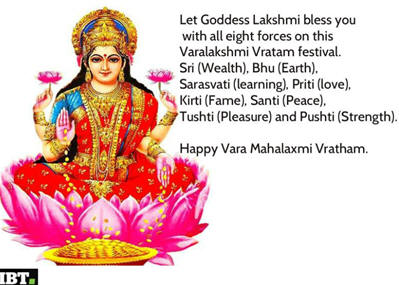
Varalakshmi vratam is a special Hindu prayer to Goddess Sri Varalakshmi (Mahalakshmi) – the consort of lord Vishnu who is the abode of auspiciousness, prosperity, and wealth. Lakshmi is symbolic of eight forces, Wealth, earth, learning, love, fame, peace, pleasure, and strength, collectively known as Ashtalakshmi. Since she is ever ready to grant boons to Her devotees, she is reffered to as ‘Varalakshmi’. Varalakshmi vratam is celebrated on the Friday before the full moon day in the month of Sravan (AugustSeptember). This vratam is observed by married women (sumangalis) for the welfare of their family. There are a number of legendary stories about the significance of Varalakshmi vratam. It is believed that Lord Siva Himself recommended this puja to Goddess Parvati, when She wanted to help the womenfolk on earth. Another legend says that a person by name Chitranemi was cursed by Sri Parvati, when he was partial during a refereeing job in a game between Lord Siva and Sri Parvati. Chitranemi got rid of this curse when he watched the Varalakshmi vratam with great attention. Legend also says that this vratam was conveyed by sage Suka to Shaunaka and others. It is also a tradition to read the story of Charumati, a woman who respected elders and loved her family. Attracted by her devotion, one day, Goddess Lakshmi appeared in Charumati’s dream. In the same dream Charumati chanted the following sloka in praise of The Goddess and also did Pradakshina to her. [Padmalaye padmakare, Sarvalokikapujite; Narayanapriye devi, Supreeta bhava sarvada]. Goddess Lakshmi blessed Charumati and advised her to perform Varalakshmi vratam. When Charumati and her friends performed the Vrata, they were showered with riches following the completion of each pradakshina. Following this event, Varalakshmi vratam became an annual event in many households. In our temple in Bridgewater, New Jersey, on the Varalakshmi vratam day, this Puja is conducted by our priests both in the morning and the evening. Women who want to observe this vrata are led through the religious proceedings by our priests. Priests also read Valalakshmi vratam story to the participants. When this puja is performed at home, Goddess Varakakshmi is invoked in a kalasa and the worship is conducted in a traditional way. Special sthothras are also chanted in praise of Goddess Varalakshmi. Varalakshmi vratam in our temple includes Lakshmi Ashtottara Sata Nama puja with gold coins in the morning and Sahasranama puja to Lakshmi gold coin mala adorned by Lord Sri Venkateswara in the evening. May the blessings of The Lord Sri Venkateswara and Sri Mahalakshmi be with you and your family. HTCS
255-153-52